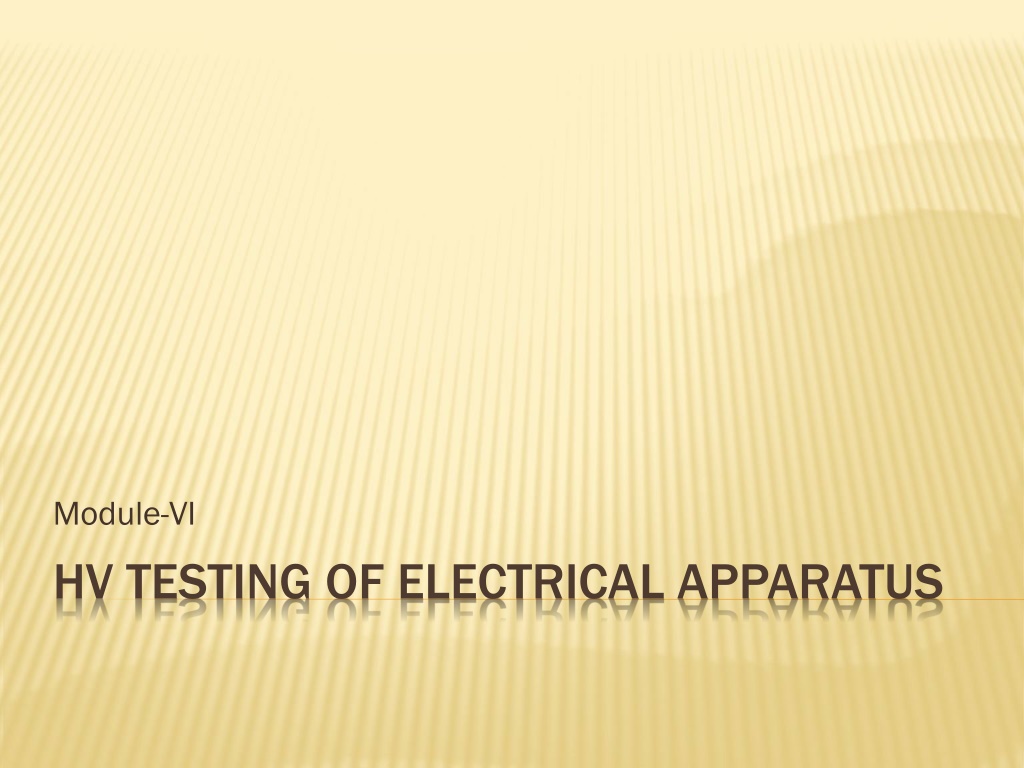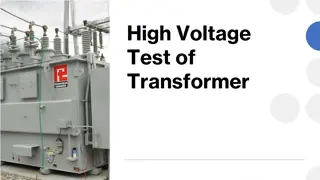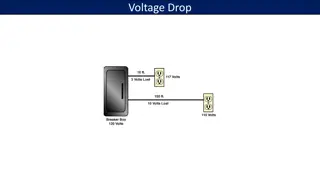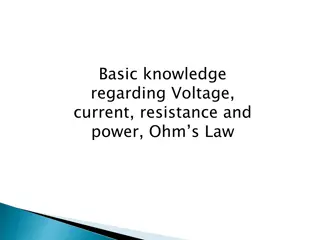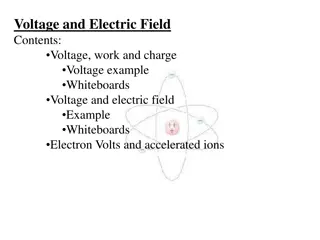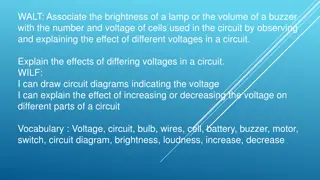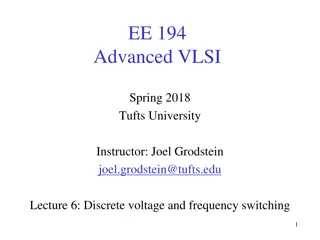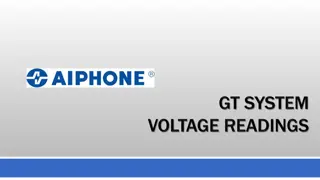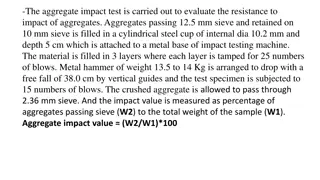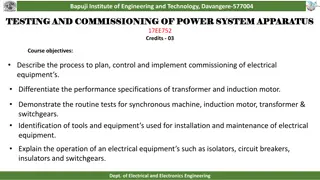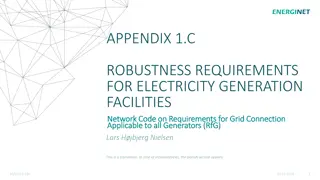High Voltage Testing of Electrical Apparatus: Terminology, Test Facilities, and Procedures
Understanding general terminology in high voltage testing such as disruptive discharge, withstand voltage, flashover, and creepage distance. Explore the test facilities provided in high voltage laboratories and the different tests conducted on equipment like transformers, lightning arresters, and cables. Learn about power frequency, impulse, and switching surge tests, as well as the importance of studying dielectric properties.
Download Presentation

Please find below an Image/Link to download the presentation.
The content on the website is provided AS IS for your information and personal use only. It may not be sold, licensed, or shared on other websites without obtaining consent from the author. Download presentation by click this link. If you encounter any issues during the download, it is possible that the publisher has removed the file from their server.
E N D
Presentation Transcript
Module-VI HV TESTING OF ELECTRICAL APPARATUS
GENERAL TERMINOLOGY OF THE TECHNICAL TERMS (a) (a) Disruptive Disruptive Discharge This is defined as the voltage which produces the loss of dielectric strength of an insulation. It is that voltage at which the electrical stress in the insulation causes a failure which includes the collapse of voltage and passage of current. Discharge Voltage Voltage In solids, this causes a permanent loss of strength, and in liquids or gases only temporary loss may be caused. When a discharge takes place between two electrodes in a gas or a liquid or over a solid surface in air, it is called flashover. If the discharge occurs through a solid insulation it is called puncture.
GENERAL TERMINOLOGY OF THE TECHNICAL TERMS (b) (b) Withstand Withstand Voltage Voltage The voltage which has to be applied to a test object under specified conditions in a withstand test is called the withstand voltage [as per IS: 731 and IS: 2099-1963]. (c) (c) Fifty Fifty Per This is the voltage which has a probability of 50% flashover, when applied to a test object. This is normally applied in impulse tests in which the loss of insulation strength is temporary. Per Cent Cent Flashover Flashover Voltage Voltage (d) (d) Hundred Hundred Per The voltage that causes a flashover at each of its applications under specified conditions when applied to test objects is specified as hundred per cent flashover voltage. Per Cent Cent Flashover Flashover Voltage Voltage (e) (e) Creepage Creepage Distance It is the shortest distance on the contour of the external surface of the insulator unit or between two metal fittings on the insulator.. Distance
TEST FACILITIES PROVIDED IN HIGH VOLTAGE LABORATORIES TEST FACILITIES PROVIDED IN HIGH VOLTAGE LABORATORIES A high voltage laboratory is expected to carry out withstand and/or flashover tests at high voltages on the following transmission system equipment: (1) Transformers (2) Lightning arresters (3) Isolators and circuit breakers (4) Different types of insulators (5) Cables (6) Capacitors (7) Line hardware and accessories (8) Other equipment like reactors, etc.
DIFFERENT TESTS CONDUCTED ON THE ABOVE EQUIPMENT ARE: (i) Power frequency withstand tests - wet and dry (ii) Impulse tests (iii) d.c. withstand tests (iv) Switching surge tests (v) Tests under polluted atmospheric conditions (vi) Partial discharge and RIV measurements In addition, high current tests at power frequency and impulse current tests on transformers, line conductors, and lightning arresters are necessary. Apart from the above facilities which are needed for routine testing, the laboratories are expected to have facilities for studying dielectric properties of insulation and insulating materials.
CLASSIFICATION OF HIGH VOLTAGE LABORATORIES CLASSIFICATION OF HIGH VOLTAGE LABORATORIES High voltage laboratories, depending on the purpose for which they are intended and the resources (finances) available can be classified into three types. (1) Small laboratories (2) Medium size laboratories (3) Large general laboratories Some salient features of these various types of laboratories are discussed
SMALL LABORATORIES SMALL LABORATORIES A small laboratory is one that contains d.c. or power frequency test equipment of less than 10 kW/10 WA rating and impulse equipment of energy rating of about lOKJoules. Voltage ratings can be about 300 kV for a.c., single unit or 500 to 600 kV a.c. for cascade units, 200 to 400 kV d.c. and less than 1OO kV impulse voltage. Normally the equipment is meant for housing in a room or hall of size 15m x 10 m x 8 m. Sometimes the equipment ratings are limited such that they can be accommodated in a room of height 5 m to 6 m only. Such laboratories are meant for Engineering Colleges and Universities who decide to build such a facility with small resources for doing high voltage tests or research or for imparting training. In such a case, it is preferable that the Engineering college or University associate with a local industry or R & D organization. It is important to decide and define the responsibilities of the parties concerned as to how the test facilities and time can be shared. Another idea is to have the university to decide to own the laboratory fully but throw open the facilities of regular technical training and high voltage testing for the clients. Here it may be mentioned that many high voltage problems can be solved by tests at moderate voltage levels. Such laboratories can be built with an investment of 2 to 10 million rupees (at 1991 prices).
MEDIUM SIZE LABORATORY MEDIUM SIZE LABORATORY AN INDUSTRIAL LABORATORY AN INDUSTRIAL LABORATORY In case of medium size laboratories, their main function will be for doing routine tests. The demand on future tests and test resources will be known to the same extent as that of the future production targets. Careful planning of such laboratories should include (i) ground transport, (ii) handling equipment like cranes etc., (iii) rationalization oftest procedures by making instruments easily accessible, possibility of increasing the maximum voltage ratings etc. Such a laboratory may initially contain a power frequency testing facility in the range of 200 to 600 kV depending on the ratings and the size of the equipment being manufactured andproposed to be- tested, such as cables, transformers etc., but its kVA rating will be much higher (100 to 1000 kVA). The impulse voltage generator required would have a rating of 20 to 100 kJ. or more. Other test equipments like the impulse current generator for testing surge diverters and d.c. test facilities for testing cables and capacitors can also be made available. In industrial laboratories not much emphasis is generally given for undertaking research work and little flexibility may be available for incorporating new equipments. and (iv) Providing room for the
LARGE SIZE LABORATORIES This type of laboratories are meant to carryout testing and undertake research work and will contain almost all high voltage and high current test equipments and facilities. The basic facilities available will be : (i) One or more h.v. test halls, (ii) Corona and pollution test chambers, (iii) Outdoor test area fen: tests on large sized equipment, transmission lines and towers etc., (iv) Controlled atmospheric test rooms/chambers, (v) Computer facilities, conference halls, library etc. with good office facilities. (vi) Provision for overnight tests and stay..
LARGE SIZE LABORATORIES The building and equipment include the workshop, material handling equipment like cranes, ladders, air cushion platforms etc. and large control and electric supply facilities (up to few KVA or MVA). The personnel connected with such a laboratory will include a director or manager, few group leaders, and section heads separately for research, testing, measurements, electronics and computer facilities etc. In addition, there will be supporting staff comprising of test engineers, technicians, librarians, office staff and skilled and semi-skilled workmen. The cost of such laboratories will be several millions of rupees. Withstand Voltages, Test Voltages and the Rating of Equipment in Large High Withstand Voltages, Test Voltages and the Rating of Equipment in Large High Voltage Laboratories Voltage Laboratories The ratings and size of test equipment chosen in the h.v. laboratories depends on the test facilities to be provided. Normally, the design of the laboratories for 230 kV system voltage and below does not pose any problems, but laboratories intended for system voltages of 400 kV and above require special attention.
VOLTAGE AND POWER RATINGS OF TEST EQUIPMENT (a) D.C. Testing Equipment High Voltage d.c, tests are performed using cascaded rectifiers. Careful consideration is necessary when tests on polluted insulation are to be performed which require currents of 50 of 200 mA, but strong pre-discharge streamers of 0.5 to 1.0 A of milliseconds duration may occur. Hence, the generator must have adequate internal reactance in order to maintain the test voltage without too high a voltage drop. The voltage ratings are given in Table 11.4, and the power rating may vary from a few kW to a few hundred kW.
VOLTAGE AND POWER RATINGS OF TEST EQUIPMENT (b) Power Frequency Testing Equipment It is known that the flashover voltage of an insulator in air or oil or in some fluid depends on the capacitance of the supply system, due to the fact that a voltage drop may not maintain the predischarges before breakdown. Hence, a minimum of about 1000 pF or more in parallel with the energized insulator is needed to determine the real flashover or puncture voltage, and the generator has to supply at least 1A in the case of clean and 5 A in the case of polluted insulator at test voltage on short circuit. Approximate values of the self-capacitances of different equipments are given below: Insulators less than 100 pF Bushings 100 to 40OpF Current transformers 200 to 600 pF Power transformers (1 MVA and above) 1000 to 8000 pF Cables per 10 m length 1000 to 3000 pF.
VOLTAGE AND POWER RATINGS OF TEST EQUIPMENT (b) The output of testing transformer will be given by P =(2 .Pi.f.C) V2x10-9kVA where, f is supply frequency, C is the capacitance in pF, and V = test voltage at the transformer terminals in kV (rms). The transformer self-capacitance and the capacitances of various high voltage leads (bushings), etc. should also be included in determining the load capacitance. From the above figures it is implied that the minimum power rating of a 1 MV testing transformer will be about 300 kV A. Usually, the power rating of a testing transformer in kVA (single unit) is approximately taken to be equal to the voltage rating in kV.
LAYOUT OF HIGH VOLTAGE LABORATORIES LAYOUT OF HIGH VOLTAGE LABORATORIES The layout of a h.v. laboratory is an important aspect for providing an efficient testing facility. Laboratory arrangements differ very much from a single equipment to multi d.c., a.c., and impulse arrangements in different testing programmes. Each laboratory has to be designed individually considering the type of equipment to be tested, the available space, other accessories needed for the tests, the storage space required, Earthing, control gear, and the safety precautions require most careful considerations. A typical layout of a high voltage laboratory accommodating a 1.0 MV a.c. testing transformer and a 3 MV impulse generator is shown in Fig. 11.2.
LAYOUT OF HIGH VOLTAGE LABORATORIES LAYOUT OF HIGH VOLTAGE LABORATORIES
HIGH VOLTAGE LABORATORIES IN HIGH VOLTAGE LABORATORIES IN INDIA INDIA
GROUNDING OF IMPULSE TESTING LABORATORIES GROUNDING OF IMPULSE TESTING LABORATORIES The ground system should ensure the following conditions: (1) imperfections of grounding system are to be avoided, as they cause excessive voltage difference between points and cause flashovers, damage, or danger to human life, (2) the imperfections will cause excessive loop currents along the sheaths of measuring cables, which will introduce errors in measurements, (3) the grounding system should be such that the voltage drop along the ground system, the voltage at a loop, and the circulating currents in the loops are avoided or minimized, (4) metal conduits should be used for the measuring and control cables to avoid neutral inductance effect between the ground grid and the cables.
GROUNDING OF IMPULSE TESTING LABORATORIES GROUNDING OF IMPULSE TESTING LABORATORIES
